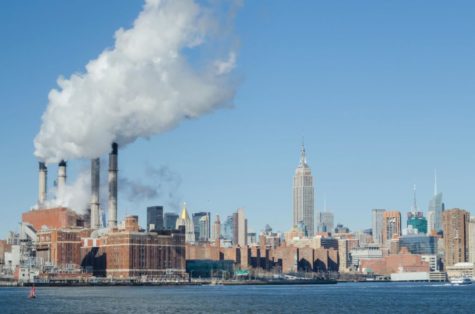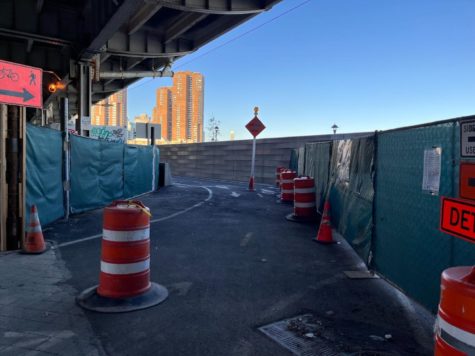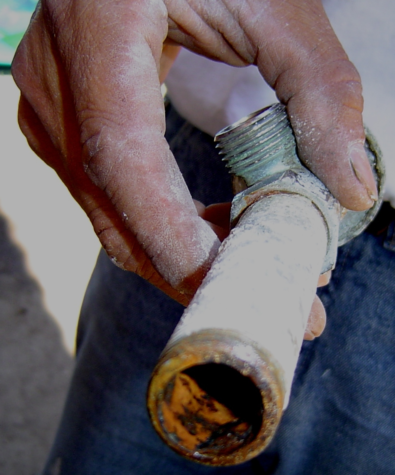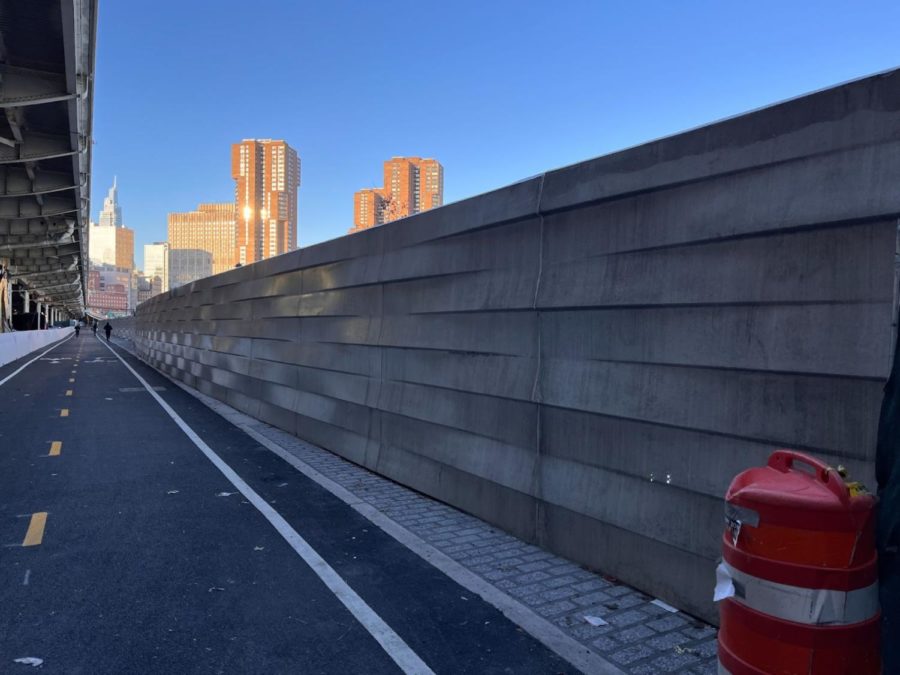Hazy Hudson, Turbid Tap: New York’s Water is Awash in Waste
Water sources in New York City face two major problems: river pollution and drinking water contamination.
Here is the East Side Coastal Resiliency floodwall along East 18th Street.
Cailin Anne was walking along Greenpoint’s Transmitter Park when she witnessed a sign of over a century’s worth of progress. She spotted a trio of dolphins swimming in the East River. For the first time since the Civil War, dolphins deemed New York City’s most polluted river acceptable to swim in. To the outside eye, this speaks wonders about the decreasing levels of pollution in this city. However, seeing the true issues impacting New York’s waters requires diving into their murky contaminants.
Water Pollution

Nearly all forms of pollution make their way into the water. Air pollution, for example, settles in bodies of water through acid precipitation. As carbon dioxide levels rise in the atmosphere, the carbon dioxide also dissolves into large bodies of water. Land pollution also seeps into streams and rivers. However, these indirect pollutants are not the only factors contaminating New York City’s rivers. These rivers face direct contamination from humans.
Con Edison, New York City’s largest utility company, has been dumping millions of gallons of hot wastewater pollution into the Hudson River Parkway, the New York Times reported. Some of this wastewater has a temperature of over 90 degrees Fahrenheit – more than 20 degrees hotter than the average summer temperature for the Hudson River. Con Edison uses the water to flush the utility’s giant boilers and to cool high-voltage electrical cables before it is dumped into the river.
The water also contains toxic metals. Although a spokesperson for Con Edison claims that the presence of toxic elements in the water was minimal, chromium and lead were still found in the water. Con Edison also stated that they have had the permits to discharge heated wastewater twice a week for the past twenty years.
The toxic metals and heated water take a toll on the underwater habitat. Many times, these disposals can prove to be very dangerous for marine life. “The dumping of heated wastewater can be harmful to marine life because it decreases the level of dissolved oxygen in the water,” Riverkeeper Habitat Restoration Manager George Jackman said. A lack of oxygen can cause aquatic creatures to suffocate.
Another major source of contamination in the Hudson River is the 1.3 million pounds of Polychlorinated-biphenyls (PCBs), industrial products or chemicals that pose a large threat to animal and human health, which were discharged into the river over half a century ago. The Hudson River has been monitored almost continuously for over 25 years and receives attention from the EPA’s Superfund program, which is responsible for cleaning up the nation’s most contaminated land. The EPA classifies 200 miles of the Hudson River as one of the largest Superfund sites in the country. New York State found that the river is not self-cleaning, and those lingering PCBs in the sediment pose a serious risk to human health and the environment.
New York City’s rivers should be treated as sanctuaries. The pollution of large bodies of water is a major factor in climate change and the consequences are already evident. New York City has begun working on preventative measures against the dangers of climate change.
Manhattan is an island surrounded by two raging rivers: the East River and the Hudson River. The government has begun working on the East Side Coastal Resiliency (ESCR) project, which entails building a floodwall along the island’s East River in response to the tangible possibility of Manhattan flooding and eventually sinking. This floodwall is New York City’s largest and most complex coastal resiliency project to date. When complete, the ESCR could protect more than 110,000 New Yorkers along Manhattan’s East Side from the region’s “worst case” anticipated storm in 2050 and is based on climate change estimates. Construction workers are driving piles over 100 feet into the ground to provide a stable structure for the wall which would increase the island’s protection so that the water has five additional feet to overpower before reaching the streets. Furthermore, the project uses an adaptive design that can accommodate the addition of two more feet of elevation throughout the project area should sea levels in the coming decades rise faster than current projections anticipate. Even so, these measures do not prevent or work against climate change. They simply meet the effects of it.

River pollution is a raging issue that will not disappear with only defensive measures. While New Yorkers have gained a few more years, the issues presented by climate change will not be forever withheld by a five-foot wall. Polluted water is only a part of the issue; to make progress a deeper look is required.
Water Contamination
The vast majority of New York City’s drinking water comes from the Catskill Delaware, a network of watersheds located 125 miles from the main city. These watersheds supply 90% of NYC’s drinking water while the other 10% comes from the Croton watershed, which is located east of the Hudson River.
To reach the city, water flows from 19 reservoirs and three lakes through an impressive system of aqueducts and tunnels, including the 100-year-old Catskill Aqueduct which extends 92 miles. NYC tap water is known to be especially clean given the measures taken by the Department of Environmental Protection (DEP) to ensure safe consumption. Once the water supply reaches the city, it is treated with chlorine, orthophosphate & UV light. The DEP also adds healthy chemicals before distributing the water to the 8.5 million people in the city.

“Inorganic compounds from pipes, such as lead, are a big concern of the government. They try reducing these compounds by purifying and filtering the water before sending it out. When the water is en route to homes, though, it has to go through more pipes and can get recontaminated,” said Joseph Savino, Director of Marketing and Outreach at Hydr8.
Water is transported through pipes that tend to rust and break down over time. As a result, pipe particles can leak into the water as it passes through and end up in somebody’s tap from which the water will be consumed. The concern surrounding corroded pipes is the contamination they leave on the water.
The Total Dissolved Solids (TDS) meter is the accepted unit of measurement for the amount of inorganic compounds present in any water supply. There is some deviation, but drinking water tends to fall between 0-500 on the TDS scale. “Zero” signifies no dissolved solids in the water while 500 is the EPA regulation level for safe water. The EPA recommends treatment for any water with a TDS above 500 because the excessive inorganic compounds make it unsafe to consume
Inorganic compounds, such as arsenic, lead, and mercury, are considered PFAS: per-fluoroalkyl and poly-fluoroalkyl substances that do not break down easily and are widespread contaminants of drinking water sources country-wide and contribute to the unhealthy TDS levels in some water supplies. PFAS are a “forever chemical,” similar to plastic, which does not go away but continues to put the health of many people at risk. Some PFAS can last eight years in the human body, leading to mass accumulation over time. PFAS do not degrade easily in the environment because the molecules have a chain of linked carbon and fluorine atoms, which have one of the strongest bonds.
Exposure to PFAS through drinking water has been linked to health issues such as kidney cancer. A 2012 Harvard study found that when PFAS exposure was doubled, children would lose 50% of the antibodies they should have had from their vaccinations — meaning that those children were not sufficiently protected against those respective diseases.
The current EPA guidelines for acceptable PFAS levels are over a thousand times higher than the previous 2016 regulation; the current regulation is .02 ppt PFAS as compared to a previous limit of 70 ppt PFAS. Essentially, the EPA wants the limits to be as close to zero as possible due to a growing body of research that continues to show the toxicity of these compounds.
PFAS levels should not be confused with TDS levels, Savino explained. In fact, PFAS tend not to show up on TDS meters because the measurement tools are not specific enough. “Unlike what one might assume, the best drinking water tends to have a TDS of around 20-35, not 0, because water at these levels includes the good nutrients but not the toxic ones,” Savino said. For instance, magnesium is a nutrient that is present in water and is beneficial for humans. “If the TDS level of water were to be 0, no dissolved substances would be present in any amount and the consumers would be missing vital elements. The materials that should be removed are lead, arsenic, and mercury.”
In New York, the TDS level is fairly low. Each of the five boroughs tends to have a consistent TDS range throughout. Manhattan has the lowest TDS of about 40-80, but it can further vary within a specific neighborhood or location. Staten Island has a TDS similar to that of Manhattan, but Brooklyn’s is slightly higher, at around 50-100. Finally, Queens and the Bronx have a TDS between 70-150. However, Long Island which is in close proximity to NYC has a much higher TDS (125-300) and shares this number with New Jersey.
The myth of New York City’s drinking water being inexplicably cleaner than most seems to be true. It is crucial to understand that the true contaminants of water cannot be determined by surface-level examination. Instead, indications such as rarely present marine life and healthier lifestyles display the full significance of clean water. Nevertheless, to discover the true potential of water hiding in the dregs of the city, New York must tackle the root issue of pollution and contamination in its water.
“Inorganic compounds from pipes, such as lead, are a big concern of the government. They try reducing these compounds by purifying and filtering the water before sending it out. When the water is en route to homes, though, it has to go through more pipes and can get recontaminated,” said Joseph Savino, Director of Marketing and Outreach at Hydr8.
Ayana Chari is a Copy Chief for 'The Science Survey.' She has always appreciated that works of journalism bring together fact and storytelling, informing...

